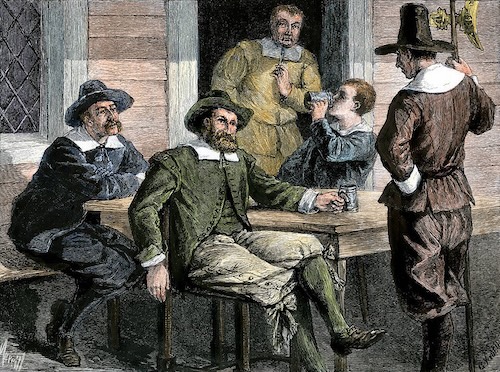The thirteen British colonies were divided into three regions: New England, the Middle Colonies, and the Southern Colonies. Each region attracted different groups of people and developed its own way of life based on the beliefs, customs, and goals of the people who lived there.
In New England, most settlers came from England and followed Puritan beliefs. These colonists wanted to build religious communities that followed their strict view of Christianity. Since the environment did not support large-scale farming, most people lived in towns and worked in trades or small family farms. Daily life centered around religion, which shaped rules, education, and even how people dressed or behaved in public. Men were expected to lead their families in prayer, and children were taught to read so they could understand the Bible. Schools were more common in New England than in other regions because education was seen as part of religious duty. People often gathered for town meetings to make decisions and solve local problems together.

The Middle Colonies were home to many different groups. People came from England, the Netherlands, Sweden, Germany, and other parts of Europe. Unlike in New England, religion in this region was not controlled by one group. Quakers, Lutherans, Catholics, and Jews were all allowed to worship freely. This made the Middle Colonies the most diverse area in the colonies. Since the land was better for farming, many people lived on small or medium-sized farms and grew crops like wheat and corn. Cities like Philadelphia and New York were also important centers of business, trade, and culture. People in the Middle Colonies often lived in mixed communities where neighbors might speak different languages or practice different religions, but still worked and traded with each other. Daily life included farming, skilled work, and participating in local markets and churches based on each group’s traditions.
In the Southern Colonies, settlers came mainly to gain land and wealth. The early colonists were mostly English, though some came from Scotland, Ireland, or other parts of Europe. Many wealthy landowners built large plantations where they grew cash crops like tobacco, rice, and indigo. These plantations depended on labor from indentured servants and enslaved Africans. Communities and farms were spread far apart, which made towns and shared public services less common. Daily life on a plantation was controlled by the landowning class, while most of the hard labor was done by others.
Smaller farmers also lived in the region, but they had less land and fewer resources. Education was limited, especially outside wealthy families, and most children learned to work rather than attend school. Religion was less strict than in New England, and many people followed the Church of England or Baptist traditions.
Each region developed its own identity based on the people who settled there and the lives they built from day to day.

